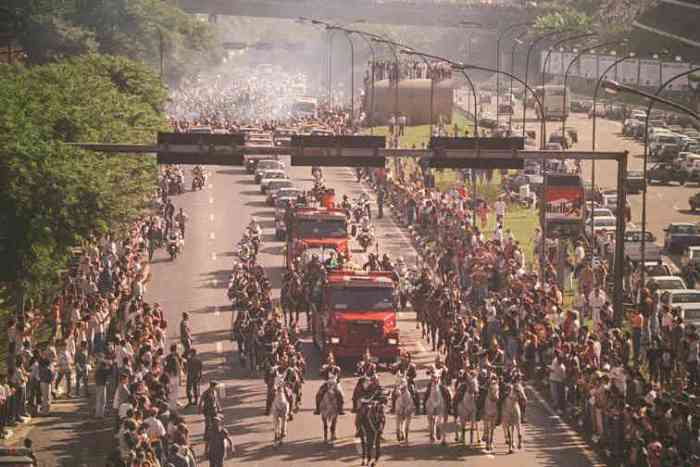
A convoy of garbage trucks marched with a coffin to the grave earlier this month in Springfield, Illinois.
Inside the coffin was Ronnie Davis, a driver for the trash hauling company, Republic. He emptied metal waste containers for commercial customers. When Davis died unexpectedly in late March his fellow coworkers organized a very special funeral procession. “Behind the hearse carrying Ronnie Davis’ casket,” read an article in the Springfield State Journal-Register, “rolled a dozen Republic Services vehicles on the way to Oak Hill Cemetery.”
At the front of the line was the truck that Davis drove, with a black wreath tied to its grill. The garbage trucks tooted their horns as they drove. “Managers and workers at Republic admired and valued Davis’ work ethic and wanted their friend’s family to know that,” said the Journal-Register article.
A funeral procession is a parade of people or vehicles or colorful and artful items meant to honor the deceased and we have covered quite the spectrum here at Digital Dying. But we’ve never written about a garbage truck funeral procession. Yet the story of Ronnie Davis and the Republic garbage trucks conveys the underlying emotion and drama of any funeral procession. When someone is well loved, their friends and family and fans want to literally get out in the streets for them, and often do so in a way that helps them remember the distinct attributes of that person.
Consider the funeral procession of Brazilian racecar driver Ayrton Senna da Silva, which Digital Dying first wrote about back in 2012. Senna was widely considered to be one of the greatest drivers of all time. He won three Formula One world championships and a record six Monaco Grand Prix titles. Senna was in the lead during the 1994 San Marino Grand Prix, in Italy, when he flew off the track on a tight corner in the seventh lap and slammed into the concrete retaining wall at 135 miles per hour. At a hospital in Bologna Senna was declared dead.
Back in Brazil, the government declared three days of national mourning. An immense funeral procession formed to escort his body from the airport into the city of Sao Paulo, a distance of 20 miles. An estimated three million people swarmed the streets to watch Senna’s coffin pass. At the time it was thought to have been the largest gathering of mourners in history.
And yet two hundred years before Senna, a funeral in France may also have breached the million mark. An estimated one million people attended the funeral procession for the 18th century French philosopher and enlightenment thinker Francois-Marie Arouet, aka, Voltaire. “The elaborate procession,” we reported, “included an orchestra with an instrument that had been revived from Roman times just for the occasion.” It was the tuba.
The mood is not always ceremonial. Occasionally, mass funeral processions can turn deadly, as happened with Iran’s Grand Ayatollah Khomeini, a controversial leader and scholar and the nation’s “Supreme Leader.” He died in 1989. This led to an immense outpouring of grief, and a massive funeral procession reportedly attended by more than 3.5 million people. “Despite the hundred-degree heat, crushing mobs created an impassable sea of black for miles as they wailed, chanted and rhythmically beat themselves in anguish,” noted one biographer. Fire trucks sprayed water on the crowd to provide relief from the heat, while helicopters carried away people killed in the procession. Eight died, and more than four hundred people were injured.
A much less tumultuous funeral procession tradition exists among the Amish community of the United States. “Buggies make their way to the cemetery, following a designated order that is written in chalk on the side of each buggy,” Digital Dying reported back in 2011. “There are no flowers, there is no singing, there are no eulogies. A hymn is read and all pray. The coffin is set in an outer wood structure called a rough box then lowered into a hand-dug grave. Gravestones are uniform and unadorned, as signs of status and wealth are shunned by the Amish. After the body has been laid to rest, all file back into their carriages and return to the home for a simple meal.”
In the other direction we have the funeral of Frankie Yale, murdered in 1928 by one of Al Cappone’s gunmen while driving his brand new Lincoln coupe down New Utrecht Avenue, in Brooklyn. “His Brooklyn funeral was the most ostentatious in mob history,” our 2010 Digital Dying article stated, “featuring a $15,000 silver casket and 110 Cadillac limousines.” One woman bolted from the crowd and spit on the gleaming coffin; Yale’s thugs had murdered her husband while in bed some years earlier.
Back in Springfield, Illinois, no one was spitting at the casket of Ronnie Davis, nor at the Republic garbage trucks that attended his funeral procession. It was all about respect. “This is just employee engagement at its best,” noted one Republic manager. He called Davis a “model employee.”
But it turns out the garbage truck funeral procession is not completely novel to Ronnie Davis. “Republic trucks also showed up for the funeral procession of employee Eugene ‘Fuzzy’ Moore Jr.,” noted the State Journal-Register article.
Next time you see a garbage truck circling your neighborhood, remember that~









